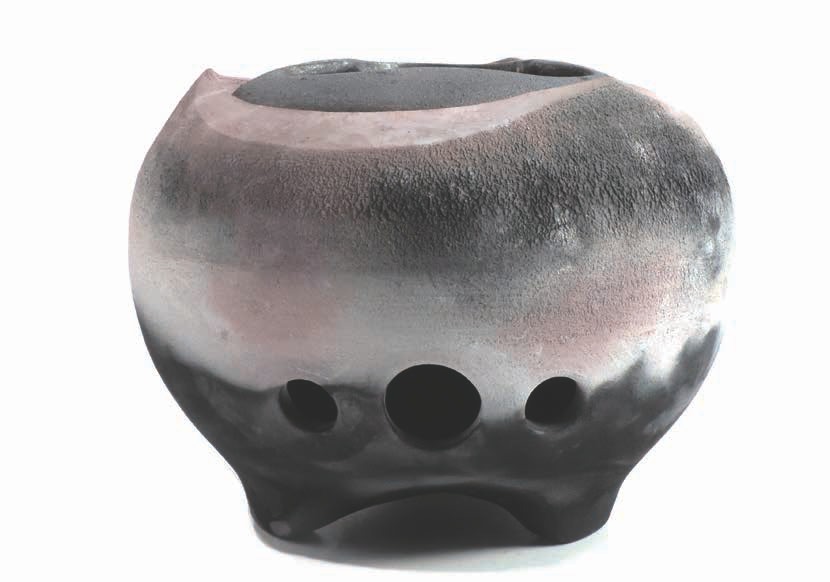
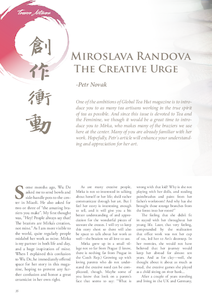 |
|
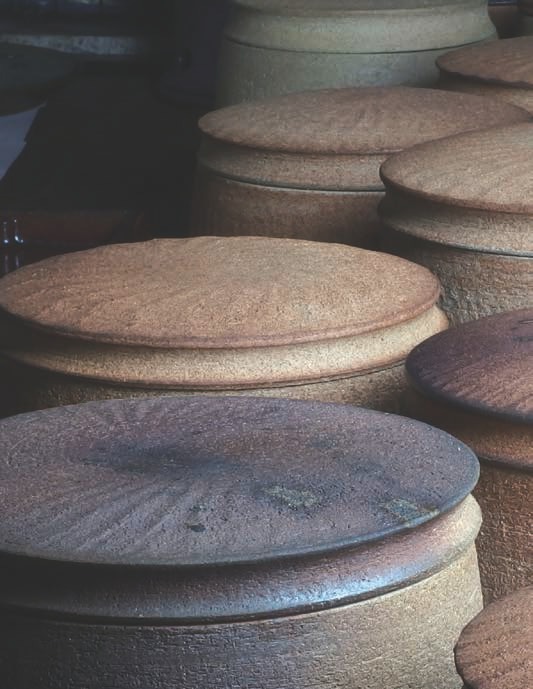
Some months ago, Wu De asked me to send bowls and side-handle pots to the center in Miaoli. He also asked for two or three of "the amazing braziers you make". My first thought was, "Hey! People always say that! The braziers are Mirka's creation, not mine." As I am more visible to the world, quite regularly people mislabel her work as mine. Mirka is my partner in both life and clay, and a huge inspiration of mine. When I explained this confusion to Wu De, he immediately offered space for her story in this magazine, hoping to prevent any further confusion and honor a great ceramicist in her own right.
As are many creative people, Mirka is not so interested in talking about herself or her life; she'd rather communicate through her art. But I feel her story is interesting enough to tell, and it will give you a bit better understanding of and appreciation for the wonderful pieces of teaware she creates. I will try to keep this story short so there will also be space to talk about her work as well - the braziers we all love to use.
Mirka grew up in a small village not so far from Prague (I know, there is nothing far from Prague in the Czech Rep.) Growing up with loving parents who do not understand the creative need can be complicated, though. Maybe some of you know that look on a parent's face that seems to say: "What is wrong with that kid? Why is she not playing with her dolls, and stealing paintbrushes and paint from her father's workroom? And why has she brought those strange branches from the forest into her room?"
The feeling that she didn't fit in stayed with her throughout her young life. Later, that very feeling, compounded by the realization that office work was not her cup of tea, led her to Art's doorstep. In her twenties, she would not have believed that her journey would keep her abroad for almost ten years. And as for clay - well, she thought about it about as much as mud, the creative games she played as a child sitting on river bank...
After a couple of years traveling and living in the UK and Germany, she settled in Chicago. From the start, she took advantage of the open education system there, taking different classes at Lake County College. And there is where the spark truly ignited. One of her major interests at that time was photography. Inspired by her photography teacher, Mirka started to work on techniques of developing photography on materials other than film or print - glass seemed too cold, metal too sharp. Her teacher's advice was: "Why don't you join a ceramics class. You can make some tiles, and then come back and we'll develop some pictures on them and see what happens." She never went back, though... Clay consumed her fully. Her old reflex camera was covered in dust for years (though she recently took it out, but that is another story).
Later, she moved to Cologne, Germany for two years to continue exploring clay at Alte Feuerwache. There was a rich community of ceramicists in Chicago, though, which pulled her back. She found her home at the Terra Incognito Ceramic Studio. She worked there as an assistant/monitor. In exchange for mopping the floor, cleaning, recycling clay, loading kilns and mixing glazes for students, she had her own space to work, fire, exhibit, and most importantly a community of people to share her art with - to share ideas, learn from and fire with. She says, "Working in Terra was hard, but it was the best school of my life. When you recycle clay by hand, load different kilns, prepare glazes and space for others, then you will really deeply understand what pottery is all about. And that's what I did." Workshops for visiting artists allowed her to be close to really exceptional ceramicists, with different approaches, sharing their techniques and ways of living a life of clay. What an environment for a ceramic student, hungry to learn!
In 2004, Mirka finally decided to make a change and move back to Czech. This happened for many reasons, but one clear vision resonated stronger than the other reasons to come back: she wanted to build a studio, a wood-fired kiln and over time to become a potter in her own right. We met each other in 2005 - two very different souls, but with similar dreams. After a short time in Mirka's small studio near Prague, we decided to take a big step and buy an old house-studio space in a small village called, "Doupě" (In English, the village name would be something like "Den", and you can imagine many things of a village by this name). The house is built of stone; it's one hundred years old, without electricity, running water or a toilet... just four walls and a feeling that this was the right space to harbor all our dreams. (Sometimes, we are still not sure why we bought this place.) Nine years later, we are still here, behind pottery wheels, two wood kilns, and many ceramic adventures and several challenging projects.
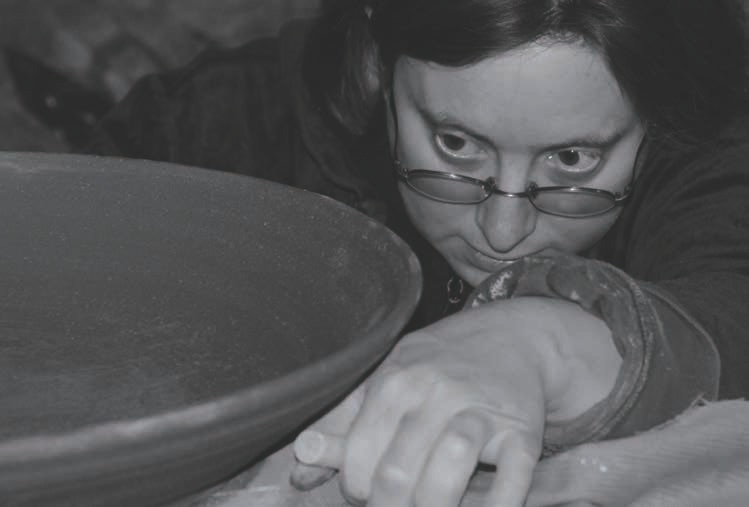
Moving from the American to the Czech dream was not without its bumps for Mirka. From the technological difficulties of using different materials here to creating a new portfolio of ceramic work for new, and very different customers, to lack of brother-sisterhood of potters, she struggled through many vicissitudes. Adopting new techniques was interesting, though, with many cool discoveries and lots of fun. Building a new body of work for a new market was challenging, indeed. Being a full time potter is not easy, no matter where you live. It took her time to get established, but she is doing very well now. She still misses the community of potters in Terra Incognito, like anyone who misses family.
When we started to work together, it was a blessing to my own ceramic work. Such knowledge and experience as she has are very rare here in Europe. Many of the techniques I use now in my work come from Mirka's knowledge and teaching. She has given me more than I can repay. But one of the few things I brought to the relationship was my focus on tea, teaware and tea community. Mirka quickly started to apply her creativity to teaware as well. From the beginning it was clear that her approach was more artistic and sculptural. With a great attention to details, she always hopes to create un-seen things. Both teaware (mostly the braziers, tea boats and puerh jars) and tableware (where her main focus lays now) have many rules, traditions, and expectations from the consumers who use them. Both give her a framework she has to fit her free, artistic soul into, finding the freedom in the form. That is beautiful in its own way, pushing the borders. Sometime challenges reveal unseen roads. Doing what you love is happiness, but it does not mean that it is always smooth sailing. Thanks to the generous support of many tea lovers, our dreams of being full-time potters has been realized. But the journey goes on...
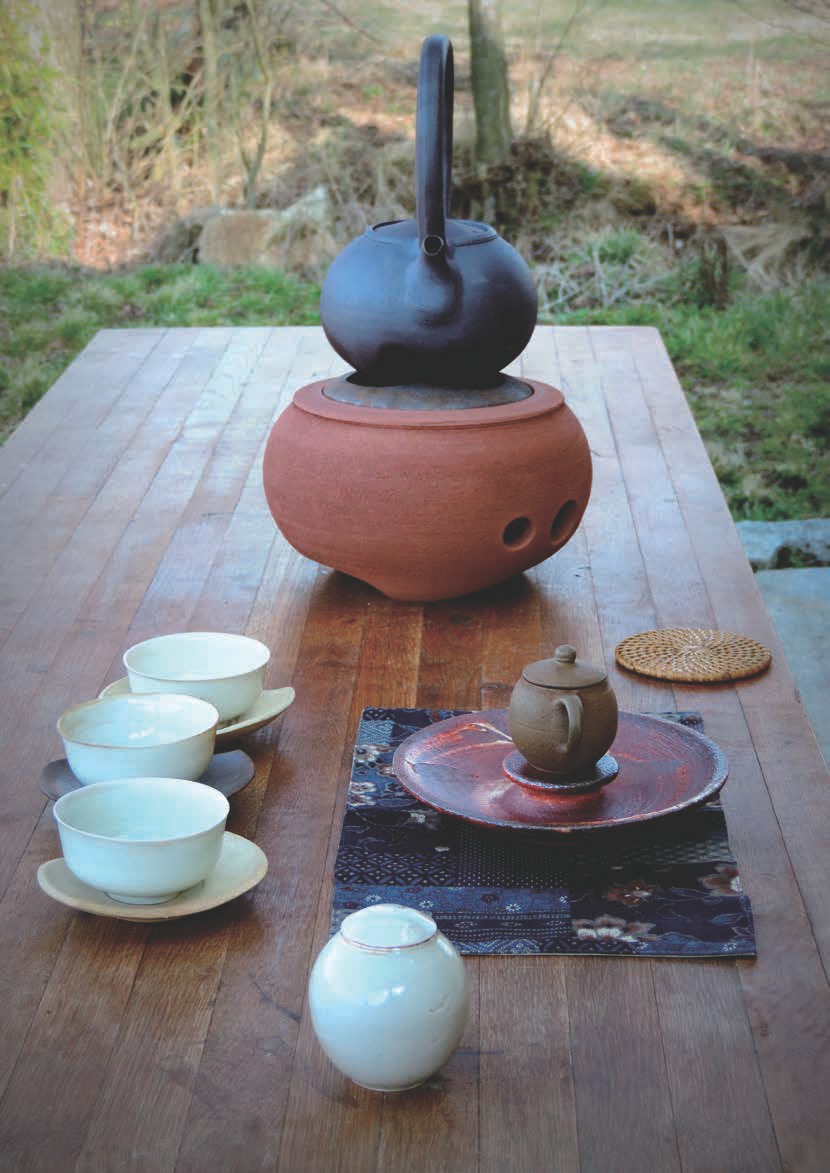
I'd also like to share with you about how Mirka's braziers were born: The first idea to create stoves for heating tea water came to us many years ago. We had many discussions with tea friends, who are students of the Japanese tea ceremony. The first stoves were from my hands, trying to copy a Japanese kama and furo. They were not bad, but we wanted something better. How many people really practice Japanese tea ceremony with charcoal? Just a few. And how many people drink tea in different ways and would like to use charcoal to heat their water? Many! For that reason, we knew we needed to try something different.
At that time, we still hadn't seen "the real thing". How did people heat water for gongfu tea in the past? After seeing first pictures of Chaozhou brazier sets, sets for Japanese Senchado, etc. we knew that that was the direction we needed to go. When a few pieces cracked, I decided to let the idea go altogether. "It is too complicated! Our clay does not respond well to thermal shock." I thought. But Mirka picked up the challenge when I set it down. And thank the Heavens she did!
She blended new clays, and after numerous trials using different combinations, shapes and designs (I had to test them all, becoming the official brazier tester!) she ended up with ceramic brazier with a kind of basket inside for the coals. It was nice-looking, could be made in different shapes and sizes, and be tuned to one's kettle size. A few months after the first series in 2012, we found a problem. Some of the baskets cracked. Some worked for a long time, but others cracked right away. We were sending new baskets overseas, refunding people, looking for solutions, etc. Finally, we stopped offering them to people. At that point, Mirka started to think outside the box, making a similarly designed basket insert into the brazier for coals, but cast in iron. Playing with this idea, she created a clay model and started to inquire with iron casting companies all over the Czech Republic. Out of thirty, just four got back to us, and finally only one of them was really able to do it. It is pretty complicated to shape iron cast molds. They made the first prototype in the spring of 2013, and after another small but important change in design, we received our first bulk order of cast iron baskets in 2014. Since then, Mirka has been exploring new clays, surfaces, and shapes of brazier to fit them. As many of you will remember from the August issue of Global Tea Hut, there are two basic brazier styles. Mirka's braziers with cast iron baskets are the "closed" variety. These are generally easier to use. In our experience, even beginners can figure out how to use them quite easily.
Mirka's spirit will never allow for a mere copy of an antique brazier. They are always fresh, creative pieces made with a deep respect for Tea and all of us sitting around it. I feel honored to witness her creative process and grateful for the opportunity to have such teaware in my daily tea practice!

